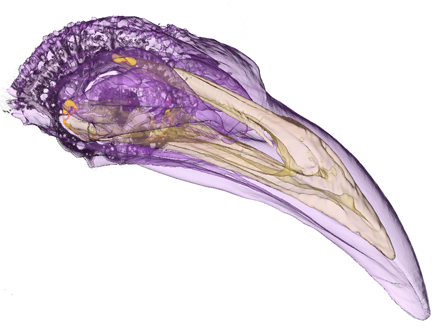Scientists may have been going in the wrong direction to find bird beaks’ built-in navigation sensors, says a provocative new study.

Pigeons and other birds appear to use the Earth’s magnetic field, along with sights and sounds, to figure out where they’re flying. But the widely accepted identification of one set of magnetically sensitive cells is “totally wrong,” says neuroscientist David Keays of the Research Institute of Molecular Pathology in Vienna.
He’s talking about work published in 2003 identifying clusters at six places in pigeons’ upper beaks as nerve cells. Those clusters have little crystals of iron compounds that might serve as biological compass needles, the earlier study proposed.
For the new study, Keays and his colleagues looked for these cells in about 250,000 thin slices of tissue from beaks of more than 200 pigeons collected across Europe. Clusters of beak cells do contain iron, but it turns out that they’re not consistent in abundance or location, and most aren’t nerve cells at all, he says. Instead, they’re immune system cells called macrophages, he and his colleagues report online April 11 in Nature.
“If that’s true, this could be really important,” says neuroethologist Henrik Mouritsen of Carl von Ossietzky University of Oldenburg in Germany. Discarding the old identification of beak sensors would mean researchers have to start from scratch looking for them.
In his own, earlier research, Mouritsen had examined some of the prepared tissue samples from the original beak study and now has seen several hundred tissue samples from the new study. “After I looked at that, I thought there was a pretty high likelihood that Dr. Keays and his lab is right,” Mouritsen says.
“Not having found the structures … does not mean that they do not exist,” say Gerta and Günther Fleissner of Goethe University Frankfurt in Germany, coauthors of the original paper. In a critique, they emphasize that they never claimed that magnetically sensitive nerve cells are the only beak cells rich in iron. “It is, in fact, a hard job to find the iron-containing [nerve] dendrite cells and, therefore, it is not astonishing at all that these authors obviously have overlooked them.”
Just how birds navigate is an intricate puzzle. Brain imaging and other research using magnetic fields in the lab suggests that birds pick up information from sensors somewhere in or near their beaks. Other research suggests a protein called cryptochrome in the retina of the bird eye is also involved in detecting the magnetic field. Pinpointing the cells involved and figuring out they work together has been a challenge.
Keays started his research hoping to identify the various compounds responsible for magnetic sensing, and at first, he says, he believed that beaks held six clusters of iron-rich nerve cells. “Everybody believed it,” he says.
But staining tissue to highlight iron-rich structures shook his faith. One pigeon had 108,000 iron-containing cells, while another bird of the same age and sex had only about 200. If the cells were part of a sensing network, “you’d expect similar-ish amounts,” he says.
Another pigeon had a beak infection, and staining showed tens of thousands of iron-containing cells at the infection site. Those samples inspired the notion that Keays and his colleagues might be looking at cells from the immune system. To test the idea, the research team combined various molecular highlighting techniques. In one test, substances that seek iron, along with antibodies that mark macrophages, indicated almost identical areas.
Keays clarifies that he’s not challenging the basic idea that birds can detect Earth’s magnetic field, and he hopes researchers will keep looking for detectors in or near the beak. He got a taste of the reaction to his approach at a conference last year. After he unveiled his early results, he says, “half the audience wanted to give me a hug, and the other half didn’t like me very much.”






